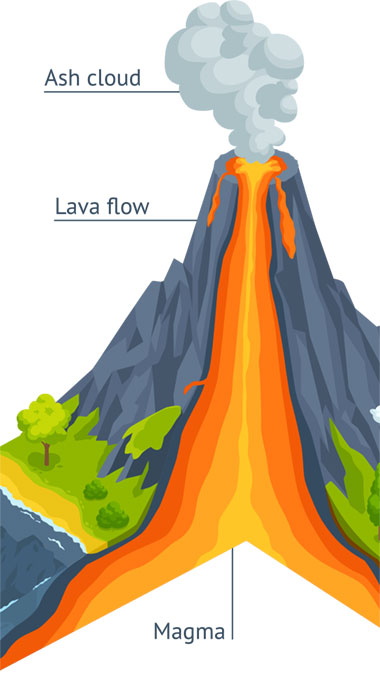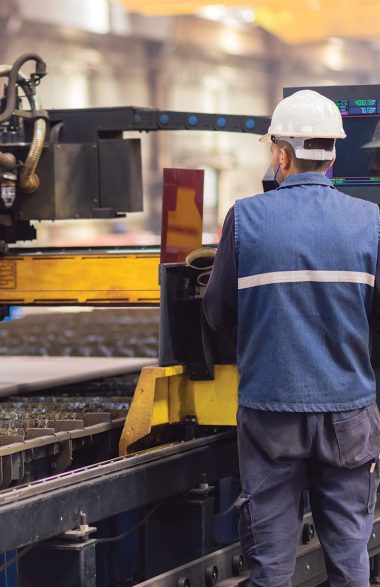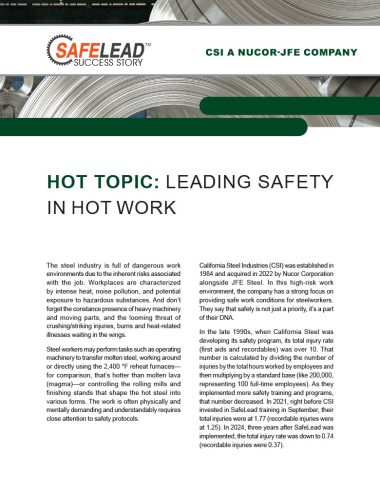Hot Topic: Leading Safety In Hot Work
The steel industry is full of dangerous work environments due to the inherent risks associated with the job. Workplaces are characterized by intense heat, noise pollution, and potential exposure to hazardous substances. And don’t forget the constant presence of heavy machinery and moving parts, and the looming threat of crushing/striking injuries, burns and heat-related illnesses waiting in the wings.
Steel workers may perform tasks such as operating machinery to transfer molten steel, working around or directly using the 2,400 °F reheat furnaces— for comparison, that’s hotter than molten lava (magma)—or controlling the rolling mills and finishing stands that shape the hot steel into various forms. The work is often physically and mentally demanding and understandably requires close attention to safety protocols.
California Steel Industries (CSI) was established in 1984 and acquired in 2022 by Nucor Corporation alongside JFE Steel. In this high-risk work environment, the company has a strong focus on providing safe work conditions for steelworkers. They say that safety is not just a priority, it’s a part of their DNA.
 In the late 1990s, when California Steel was developing its safety program, its total injury rate (first aids and recordables) was over 10. That number is calculated by dividing the number of injuries by the total hours worked by employees and then multiplying by a standard base (like 200,000, representing 100 full-time employees). As they implemented more safety training and programs, that number decreased. In 2021, right before CSI invested in SafeLead training in September, their total injuries were at 1.77 (recordable injuries were at 1.25). In 2024, three years after SafeLead was implemented, the total injury rate was down to 0.74 (recordable injuries were 0.37).
In the late 1990s, when California Steel was developing its safety program, its total injury rate (first aids and recordables) was over 10. That number is calculated by dividing the number of injuries by the total hours worked by employees and then multiplying by a standard base (like 200,000, representing 100 full-time employees). As they implemented more safety training and programs, that number decreased. In 2021, right before CSI invested in SafeLead training in September, their total injuries were at 1.77 (recordable injuries were at 1.25). In 2024, three years after SafeLead was implemented, the total injury rate was down to 0.74 (recordable injuries were 0.37).
CSI found that adherence to safety policies, procedures and regulations within a facility is tied directly to the strength of the safety culture. A successful safety culture is dependent upon a strong commitment to safety, communication, employee engagement and sustainable training. For illustrative purposes, let’s go back to the molten lava for a second. Lava erupts from a volcano when the magma (molten rock) and gas accumulate enough pressure to force their way up the volcano and spill out onto the earth. Volcanoes become dormant when the magma can no longer reach the volcano. The same thing happens in facilities. If supervisors can’t reach employees, those employees will become dormant when it comes to safety.
Here’s what Brad Bray, Director, Safety and Plant Protection, Nucor, California Steel Industries, Inc., had to say about their culture:
“In the past, we really had that ‘have to’ attitude. We had rules and we had to abide by them, but that was because our supervision told us we had to. Now I can see, especially in the past couple of years, that trend is much more a ‘want to’ attitude. We’re having a lot of people step up and talk about safety who have never done that before. And taking a proactive stance in making sure that their teammates around them—especially the new teammates—are taken care of and taught correctly about how to handle safety situations. We’ve seen a great deal of improvement in communication and teammate empowerment—both of those lead to very good results. And those are direct results of what we have done with SafeLead, in my opinion.”
CSI incorporated SafeLead into their safety management system. A key component of SafeLead training is helping frontline leadership better communicate with their employees. On the safety website CSI created, teammates can report safety observations and supervisors can complete a SafeLead contact form. Their purpose behind implementing this website was to create a platform for their teammates to communicate with management—everything from near misses to observations. They also wanted to incorporate SafeLead training into the supervisor contacts to make sure they were applying what was learned in the SafeLead training to enhance their safety program and strengthen supervisors’ communication with teammates.
 Supervisors were asked to interact with teammates based on the SafeLead modules. This helps to have targeted information that is disseminated between teammates and supervisors. CSI sets goals for the number of contacts that supervisors have with teammates; their first goal was 2,500 contacts and they surpassed that, bringing in 4,264 contacts. The next goal they set was for 5,000 contacts and they were well on their way to achieving that goal as of this writing. The teammate observations have also increased the near misses being reported in the facility. In 80% of the contacts between teammates and supervisors, the teammate has resolved the situation and no further action was required.
Supervisors were asked to interact with teammates based on the SafeLead modules. This helps to have targeted information that is disseminated between teammates and supervisors. CSI sets goals for the number of contacts that supervisors have with teammates; their first goal was 2,500 contacts and they surpassed that, bringing in 4,264 contacts. The next goal they set was for 5,000 contacts and they were well on their way to achieving that goal as of this writing. The teammate observations have also increased the near misses being reported in the facility. In 80% of the contacts between teammates and supervisors, the teammate has resolved the situation and no further action was required.
The data is collected weekly and entered into their system to produce a Supervisor Safety Scorecard. Part of the scorecard is the number of contacts made between supervisors and teammates. The leading indicators on the scorecard add up to 100 points. It’s a simple scoring system; if supervisors complete all of their inspections and audits, the maximum score of 100 points is obtained. There is also an incident severity score based on probability, exposure and consequence, and that determines the risk factor number. Supervisors can regain points in this section if they input all of their corrective actions and minimize the risk of reoccurrence for that type of incident. A supervisor’s score tabulated with the number of people they supervise produces a ranking of one to four.
After their first SafeLead implementation, CSI implemented “Do Wells” and “Do Betters”. They wanted to outline what they did well in the SafeLead training and what they could do better.
Do Wells
- SafeLead was accepted well by supervisors and teammates.
- Supervisors enjoyed the small class, short duration classes and flexible scheduling.
- SafeLead increased communication:
- Allowed an avenue to discuss safety through planned and unplanned contacts
- Allowed teammates and supervisors to increase trust and acceptance of the safety culture
- Allowed teammates to forward safety concerns to management
- SafeLead played a role in the reduction of injuries while allowing for an increase in reporting of leading indicators.
Do Betters
- Define No Blame vs. Accountability concept before the start of classes.
- Struggled with the concept at first, but once the statement was defined within the framework of the company’s current policies, it was easier to digest. CSI had a previously defined accountability policy that was confusing to SafeLead participants when “no blame” was introduced.
When CSI interpreted the data implemented by teammates and supervisors, they found record-low injury rates with all KPIs on a positive trend. They had increased reporting with a substantial boost to near-miss reporting. Communication between supervisors and teammates substantially improved and the visibility of safety issues was more prominent for management members. SafeLead enhanced safety and performance outcomes by providing frontline leaders with the skills needed to effectively address human factors, worker performance, communication and safety. One other notable win for CSI was the sustainability of SafeLead training they gained by integrating SafeLead into the safety management system.
The CSI information and quotes used in this case study were taken from a SafeStart Lunch and Learn session conducted by Brad Bray, Director, Safety and Plant Protection, Nucor, California Steel Industries, Inc. Click here to watch the Lunch and Learn session.

Get the PDF
You can view or download a PDF of this case study using the button below.

